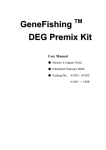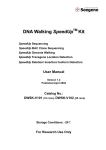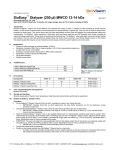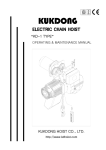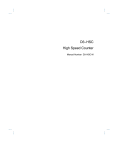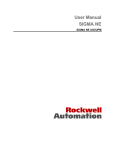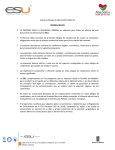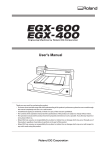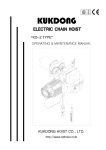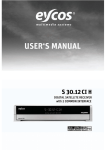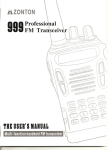Download SeeGene_DEGKit 509KB May 19 2008 12:55:46 AM
Transcript
Cat. No. K1021-K1026 Innovation in Gene Discovery & Molecular Diagnostics www.seegene.com Seegene s Product User manual - V. 5.1 Published Nov. 2007 GeneFishing™ Kit G G Table of Contents G G 1. Notices to Customers 1 1.1 Product Warranty and Liability------------------------------------ 1.2 Safety Warning and Precautions--------------------------------- 1 1.3 Notice to Customers------------------------------------------------- 1 2. Introduction 2.1 ACPTM Technology---------------------------------------------------- 2 2.2 GeneFishingTM DEG Premix kits 2.2.1 Overview------------------------------------------------------- 4 2.2.2 Principle-------------------------------------------------------- 5 2.2.3 Key Features-------------------------------------------------- 8 3. Components 3.1 List of Components --------------------------------------------------- 10 3.2 Storage Conditions ---------------------------------------------------- 12 3.3 Reagents and Equipments to be Supplied by User ----------- 12 4. Protocol 4.1 Positive Control Experiments--------------------------------------- 13 4.2 Protocol for GeneFishingTM DEG Premix Kit 4.2.1 Reverse Transcription-------------------------------------- 14 4.2.2 GeneFishingTM PCR---------------------------------------- 15 5. Expected Results -------------------------------------------------------- 17 6. Troubleshooting Guide ------------------------------------------------ 19 7. Ordering Information --------------------------------------------------- 21 www.seegene.comG G 1 Notices to Customers 1.1 Product Warranty and Liability Seegene guarantees the performance of all products as described when they are used according to the instructions in this manual. Any problem that occurs for reasons other than misuse should be reported to Seegene immediately. This warranty limits our liability for product replacement. 1.2 Safety Warning and Precautions G This product is limited to research use only. It is not recommended or intended for the diagnosis of disease in humans or animals. Do not use internally or externally in humans or animals. 1.3 Notice to Customers The PCR process is covered by patents owned by Hoffman-La Roche Inc. No license or immunity under any other patent is either expressed or implied by the sale of any Seegene product. 1 www.seegene.comG G 2 Introduction 2.1 ACPTM Technology P The specificity with which a primer anneals to its target sequences is the most critical factor for successful target-specific PCR amplification. The principle of our ACPTM Technology (patent pending) focuses on an oligonucleotide primer that anneals with exquisite specificity to the intended template, therefore allowing only the target products to be amplified. The primer is denoted Annealing Control Primer (ACPTM), and it has a unique tripartite structure. As shown in Figure 1, it has distinct 3ƍ- and 5ƍ-end portions separated by a regulator, which interact with the template in turn during a two-stage PCR. ACP (Annealing Control Primer) 5’G c b Designation aG 3’ Function a. Core sequence-----------------Anneal at the 1st PCR Stage (targeting) b. Regulator------------------------Universal sequence c. Universal sequence----------Anneal at the 2nd PCR Stage Fig. 1. ACPTM Structure www.seegene.comG 2 G The 3ƍ-end core, which is designated as ‘a’ in Figure 1, is the targeting portion that consists of a hybridizing sequence that is substantially complementary to a site on a nucleic acid template. The 5ƍ-end portion (designated as ‘b’ in Figure 1) has a universal sequence. The regulator bridging the core and universal sequences of the ACP (designated as ‘c’ in Figure 1) plays a key role in controlling the annealing of each portion to the template. The ACP system requires a two-stage PCR (ACPTM-based PCR) amplification to maximize the functions of each portion as follows: 1st stage PCR to generate a specific PCR product During the 1st stage PCR, the conditions are set such that the 3ƍ-end core portion of the ACP anneals to a specific site on the template. The annealing of the regulator to the template is not favored under these conditions. Consequently, the regulator interrupts the annealing of the 5ƍ-end portion to the template, thereby restricting the primer-annealing portion to the 3ƍ-end. The reaction equilibrium in the 1st stage PCR lies more favorably towards the specific annealing of the 3ƍ-end portion sequence than the non-specific annealing under this annealing temperature. This results in an improvement of the primerannealing specificity. Thus, the effect of the regulator on the 5ƍand 3ƍ-end portions of the ACP is one of the key features of the ACPTM Technology. 2nd stage PCR to amplify the 1st PCR product The product generated by the annealing and extension of the 3ƍ-end portion sequence of the ACP in the 1st stage PCR is amplified in the 2nd stage PCR, which is conducted under high stringency conditions. This prevents further annealing of the 3´-end core portion of the ACP to the original template. Instead, only the sequences at the 3ƍ- and 5ƍ-ends of the 1st PCR product act as donors of priming sequences for the amplification. This results in the amplification of only the target product, with an amplification efficiency that is close to the theoretical optimum of a two-fold increase of product for each PCR cycle. 3 www.seegene.comG G 2.2 GeneFishingTM DEG Premix Kit 2.2.1 Overview Sample A Sample B (ex. Normal) (ex. Tumor) Synthesize first-strand cDNA by RT using dT-ACP1 First-strand cDNAs First-strand cDNAs Amplify differentially expressed cDNAs by GeneFishingTM PCR with an arbitrary ACP and dT-ACP2 PCR products PCR products Display DEGs on an agarose gel 5’ primer ACP1 ACP2 ACP3 ACP4 ACP5 dT-ACP2 3’ primer AB AB AB AB AB Fig. 2. Overview of the GeneFishingTM DEG Premix Kits www.seegene.comG 4 G 2.2.2 Principle The GeneFishingTM DEG Premix Kits are designed to identify differentially expressed genes (DEGs) in two or more nucleic acid samples. The designing of the kit specifically focused on overcoming the disadvantages and limitations of current gene expression profiling-related methodologies, such as the microarray and differential display techniques. The GeneFishingTM DEG Premix Kits require the following three steps, which consist of reverse transcription (RT) and a two-stage PCR (GeneFishingTM PCR, see Figures 2 and 3, pages 4 and 7, respectively): Step 1: RT is conducted using dT-ACP1 to synthesize the firststrand cDNAs from the samples. The 3ƍ-end core portion of dTACP1 consists of a hybridizing sequence that is complementary to the poly A region of mRNA transcripts. This results in the first-strand cDNA bearing the universal sequence of dT-ACP1 at its 5´-end. Step 2: The first-strand cDNA resulting from the first step is diluted and placed in a PCR tube with an arbitrary ACP and dT-ACP2. The 3ƍend core portion (10-mer) of the arbitrary ACP consists of a hybridizing sequence that is sufficiently complementary to a region on the first-strand cDNAs. A single PCR cycle (1st stage PCR) is conducted under conditions that permit only the arbitrary ACP to anneal with its 3´-end core to the first-strand PCR. These conditions do not allow the 3ƍ-end core portion of dT-ACP2 to anneal to the firststrand cDNA. The result of the 1st stage PCR is the synthesis of second-strand cDNA that bears the complementary sequence of the universal sequence of dT-ACP1 on its 3´-end and the universal sequence of the arbitrary ACP on its 5´-end. This step ensures that no artifacts and dT-ACP2/dT-ACP2 products are obtained. 5 www.seegene.comG G Step 3: The mixtures in the PCR tubes arising from step 2 are then subject to 2nd stage PCR under high stringency conditions that allow both dT-ACP2 and the arbitrary ACP to respectively anneal to the 3ƍand 5ƍ-ends of the arbitrary ACP-primed second-strand cDNA generated in step 2. These annealing events exclusively involve the universal sequences of the two primers since the 3´-end of the second-strand cDNA is complementary to the universal sequence of the arbitrary ACP while the 5´-end is recognized by the universal sequence of dT-ACP2. This results in the amplification of the targeted PCR products ONLY. www.seegene.comG 6 G G \’ Zƍ OXPG First-strand cDNA synthesis dT- ACP1 \’ G i First-strand cDNA is synthesized by RT using dTACP 1 (1-2). OYPG G G G G GeneFishingTM PCR G G \’ dT-ACP2 G First-stage PCR for strand cDNA synthesis G OZPG \’ Arbitrary ACP G second- i Annealing is allowed at Tanneal=50qC, which is G high enough to prevent the core of dT-ACP2 from binding(3a). OZPG i Only 10-mer core of arbitrary ACP is able to bind G to the first-strand cDNA with 8-10 base pair matches (3b). G i Second-strand cDNA is synthesized in only one O[PG cycle (4). G G G G G G G ZƍG dT-ACP2 \’ Arbitrary ACP Second-stage PCR for amplifying the second-strand cDNA G Zƍ i 35~40 cycles of PCR are performed at O\PG G Tanneal=65qC, which is stringent enough to O\PG permits the binding of universal sequences to G each other. prevent core sequences from annealing yet still i Arbitrary ACP and dT-ACP2 cannot anneal on O]PG the first-strand cDNA at 65qC (5a). i The second-strand cDNA is amplified by priming the Arbitrary ACP and dT-ACP2 at 3’- and 5’ends, respectively (5b). i Only target PCR products are amplified (6). Electrophoresis of PCR products on an agarose gelG NO false positives! Fig 3. Flow chart of cDNA synthesis and the GeneFishingTM PCR 7 www.seegene.comG G 2.2.3 Key Features (1) No false positives GeneFishingTM DEG Premix Kits identify Differentially Expressed Genes (DEGs) and never fail upon confirmation by Northern blot analysis (or RT-PCR)! The problem of false positives has been a major remaining bottleneck for current DEG-profiling methodologies, such as the microarray and differential display technologies. The lack of false positives allows the researcher to concentrate on authentic DEGs. (2) No PAGE required, as an agarose gel is sufficient The Annealing Control Primer (ACP) dramatically improves the specificity and sensitivity of PCR amplification and results in only specific PCR products. In addition, the GeneFishing™ Technology requires small amounts of starting material. The PCR products can be detected on standard ethidium bromide-stained agarose gels, and hence, obviating the use of PAGE gels with the attendant issues in handling and use. The bands shown on agarose gels by GeneFishing™ Technology are of adequate resolution to be detected by Northern blot analysis. (3) No expensive detection methods The use of Radioactive/fluorescent detection methods is limited in terms of its cost and risks. Such expensive detection methods are additional drawbacks of current gene expression profiling methods. Therefore, the detection of PCR products by EtBr staining of agarose gels is a key benefit of the GeneFishingTM DEG Premix Kit. T (4) Guaranteed reproducibility The GeneFishingTM DEG Premix Kits provide highly reproducible PCR products time after time as all reagents are provided with the kit. This ensures that variations caused by the use of old, incompatible reagents are prevented. www.seegene.comG 8 G (5) No special skills required GeneFishingTM Technology is a robust PCR based technology and as such is simple to use. (6) Speedy and cost-effective The GeneFishingTM DEG Premix Kits enable researchers to identify authentic DEGs within 5 hrs and not to waste time on accessing false positives. In contrast, all other current DEG profiling methods require intensive downstream work and time to identify the authentic DEG candidates. (7) Wide range of PCR products Each GeneFishingTM PCR reaction generates a wide range of PCR products ranging from 150 bp to 2 kb, which not only increases the chances of identifying DEGs and but also provides more significant sequence information for the prediction of gene function. 9 www.seegene.comG G 3 Components 3.1 List of Components x dT- ACP1 (10 PM): For Reverse Transcription, 1 vial dT-ACP1: 5ƍ-CTGTGAATGCTGCGACTACGATXXXXX(T)18 -3ƍ x dT- ACP2 (10 PM): For GeneFishingTM PCR, 1 vial dT-ACP2: 5ƍ-CTGTGAATGCTGCGACTACGATXXXXX(T)15 -3ƍ x Arbitrary ACPs (5 PM): For GeneFishingTM PCR Cat. No. Note Arbitrary ACPs vial K1021 : K1022 : Arbitrary ACP 1 Arbitrary ACP 21 – Arbitrary ACP 20 – Arbitrary ACP 40 20 20 K1023 : K1024 : Arbitrary ACP 41 Arbitrary ACP 61 – – 20 20 K1025 : K1026 : Arbitrary ACP 81 – Arbitrary ACP 100 Arbitrary ACP 101 – Arbitrary ACP 120 Arbitrary ACP 60 Arbitrary ACP 80 20 20 Note: All of the GeneFishingTM DEG Premix Kits (K1021~ K1026) contain 20 arbitrary ACPs. The 3ƍ-end core portion of each arbitrary ACP consists of a 10-mer of randomly selected nucleotides, while the 5´-end consists of the universal sequence. For example, the 20 arbitrary ACPs enclosed in the K1021 have the following sequences: www.seegene.comG 10 G ACP1 : 5ƍ-GTCTACCAGGCATTCGCTTCATXXXXXGCCATCGACC-3ƍ ACP2 : 5ƍ-GTCTACCAGGCATTCGCTTCATXXXXXAGGCGATGCC-3ƍ ACP3 : 5ƍ-GTCTACCAGGCATTCGCTTCATXXXXXCCGGAGGATG-3ƍ ACP4 : 5ƍ-GTCTACCAGGCATTCGCTTCATXXXXXGCTGCTCGCG-3ƍ ACP5 : 5ƍ-GTCTACCAGGCATTCGCTTCATXXXXXAGTGCGCTCG-3ƍ ACP6 : 5ƍ-GTCTACCAGGCATTCGCTTCATXXXXXGGCCACATCG-3ƍ ACP7 : 5ƍ-GTCTACCAGGCATTCGCTTCATXXXXXCTGCGGATCG-3ƍ ACP8 : 5ƍ-GTCTACCAGGCATTCGCTTCATXXXXXGGTCACGGAG-3ƍ ACP9 : 5ƍ-GTCTACCAGGCATTCGCTTCATXXXXXGATGCCGCTG-3ƍ ACP10: 5ƍ-GTCTACCAGGCATTCGCTTCATXXXXXTGGTCGTGCC-3ƍ ACP11: 5ƍ-GTCTACCAGGCATTCGCTTCATXXXXXCTGCAGGACC-3ƍ ACP12: 5ƍ-GTCTACCAGGCATTCGCTTCATXXXXXACCGTGGACG-3ƍ ACP13: 5ƍ-GTCTACCAGGCATTCGCTTCATXXXXXGCTTCACCGC-3ƍ ACP14: 5ƍ-GTCTACCAGGCATTCGCTTCATXXXXXGCAAGTCGGC-3ƍ ACP15: 5ƍ-GTCTACCAGGCATTCGCTTCATXXXXXCCACCGTGTG-3ƍ ACP16: 5ƍ-GTCTACCAGGCATTCGCTTCATXXXXXGTCGACGGTG-3ƍ ACP17: 5ƍ-GTCTACCAGGCATTCGCTTCATXXXXXCAAGCCCACG-3ƍ ACP18: 5ƍ-GTCTACCAGGCATTCGCTTCATXXXXXCGGAGCATCC-3ƍ ACP19: 5ƍ-GTCTACCAGGCATTCGCTTCATXXXXXCTCTGCGAGC-3ƍ ACP20: 5ƍ-GTCTACCAGGCATTCGCTTCATXXXXXGACGTTGGCG-3ƍ x Control cDNAs (Kidney, 10 ng/Pl), 1 vial These control cDNAs were synthesized from total RNAs isolated from adult mouse kidney tissues. x Control cDNAs (Liver, 10 ng/Pl), 1 vial These control cDNAs were synthesized from total RNAs isolated from adult mouse liver tissues. x Control ACP (5 PM): For GeneFishingTM PCR, 1 vial x 2X SeeAmpTM ACPTM Master Mix (280 rxns), 4 vials 11 www.seegene.comG G 3.2 Storage Conditions In case of the SeeAmpTM ACPTM master mix, 4 for short-term storage and -20 for long-term storage are recommended. Avoid repetitive thawing as it may decrease the activity of the master mix. The master mix is proven to be stable for at least 3 months at 4. 3.3 Reagents and Equipments to be Supplied by the User RNase-free H2O RNase inhibitor Reverse transcriptase 2 mM dNTP Thermal cycler Micro-centrifuge www.seegene.comG 12 G 4 Protocol 4.1 Positive Control Experiments i Please consider the following in prior to your experiments. Important !! If you are using GeneFishingTM DEG Premix kits for the first time, please establish the GeneFishingTM PCR conditions with the positive control experiments. The positive control experiments should be conducted using the control cDNAs as templates and a primer set of Control ACP and dTACP2 (provided in the kit) according to the instructions in this protocol. tG 13 3 Pl 2 Pl 1 Pl 4 Pl 10 Pl Control cDNA-Kidney or Liver Control ACP dT-ACP2 (10 uM) Distilled water 2X SeeAmpTM ACPTM Master Mix 20 Pl Total volume P www.seegene.comG sG Refer the instructions on page 15. r G You can assume that the initial experiment conditions are set up when the pattern of the positive control displayed on the agarose gel is similar with the figure on the right. G 4.2 Protocol for GeneFishingTM DEG Premix Kits 4.2.1 Reverse Transcription 1. Add the following reagents to a RT tube on ice. ? Pl 2 Pl ? Pl 9.5 Pl Note Total RNA (3 Pg) 10 PM dT-ACP1 RNase-free water Note: Mix the reagents by tapping or pipetting. Note: In order to identify differentially expressed bands between RNA samples, it is important to add equal amount of RNA to each tube. 2. Incubate the tube at 80ଇ for 3 min. 3. Chill the tube on ice for 2 min and spin the tube briefly. 4. Add the following reagents to the tube from step 3. 4 Pl 5 Pl 0.5 Pl 1 Pl 20 Pl 5. 6. 7. 8. Note 5X RT buffer 2 mM dNTP RNase inhibitor (40 u/Pl) M-MLV reverse transcriptase (200 u/Pl) Total volume Incubate the tube at 42ଇ for 90 min. Heat the tube at 94ଇ for 2 min. Chill the tube on ice for 2 min and spin the tube briefly. Dilute the first-strand cDNA by adding 80 Pl of DNase-free water. Note: Store all cDNA samples at -20ଇ until ready for use. www.seegene.comG 14 G 4.2.2 GeneFishingTM PCR 1. Add the following reagents to a PCR tube on ice. Diluted first-strand cDNA (~50 ng) 3~7 Pl 2 Pl 1 Pl Note Note Important !! ? Pl 10 Pl 5 PM arbitrary ACP (one of the arbitrary ACPs) 10 PM dT-ACP2 Distilled water 2X SeeAmpTM ACPTM Master Mix 20 Pl Total volume P Note: Depending on the samples, different amounts of diluted firststrand cDNA can be used as templates for GeneFishingTM PCR. High amounts of the starting material (the first-strand cDNA) results in perfect reproducibility and amplification of rare mRNAs. It also permits the use of the ethidium bromide-stained agarose gel to detect differentially expressed products. We recommend using 3~5 Pl of the diluted first–strand cDNA as the template for the GeneFishingTM PCR. Note: A primer set consisting of one of the ten arbitrary ACPs in the kit and dT- ACP2 should be used as the 5ƍ and 3ƍ primers in each PCR reaction. 2. Place the tube in a preheated (94ଇ) thermal cycler. Note: It is important to preheat (94ଇ) the thermal cycler before placing the tube in the thermal cycler. 3. Immediately commence the PCR reaction using the following program. Note 15 Segment 1 2 3 4 No. of cycles 1 1 1 40 5 1 Temperature 94ଇ 50ଇ 72ଇ 94ଇ 65ଇ 72ଇ 72ଇ Duration 5 min 3 min 1 min 40 sec 40 sec 40 sec 5 min Note: We recommend the GeneAmp PCR System 9700 of Applied Biosystems that has a heated lid. www.seegene.comG G Note Note 4. Electrophorese 2~3 Pl of the PCR products on a 2% agarose gel containing EtBr. Note: If the band intensity of the DEGs of your sample is very weak, the intensity can be increased by raising the amount of starting material (diluted first-strand cDNA) or the ACP primer concentration in the GeneFishingTM PCR. 5. Extract the differentially expressed bands from the agarose gel. Note: The gel extraction kit (e.g. QIAquick Gel extraction kit (Qiagen, cat. No. 28704) or the GENECLEAN II kit (Q.BIOgene, cat. No. 1001400)) is recommended to extract the differentially expressed bands from the agarose gel. 6. Clone the product into a TA cloning vector Note Note: We suggest that you avoid re-amplifying the extracted PCR product, because using the same primer set in re-amplification may generate smearing or non-specific products.” Even if the differentially expressed band of interest is faint, the extracted DNA should be directly used for cloning into a TA cloning vector. In this case, we strongly recommend to use an efficient TA cloning system (e.g., the Invitrogen, TOPO TA Cloning Kit). www.seegene.comG 16 G 5 Expected Results Examples of GeneFishingTM DEG Premix Kits Applications Various experiments to compare differentially expressed genes (DEGs) in two or more RNA samples from different organisms were conducted with the ACPs of the GeneFishing™ Premix DEG Kits in accordance with the instructions given in this User Manual. Below are examples of resulting data shown by agarose gel photographs. These agarose gels show the typical results that are generated by such experiments. Note that the number of PCR products can vary depending on the type of sample loaded. A. Mouse Conceptus Tissues (E4.5 vs. E11.5 vs. E18.5) M A B C A B C A B C Lane Template A E4.5 B E11.5 C E18.5 M 100 bp Ladder B. Human Brain Tissues (Normal vs. Tumor) M A B A B A B A B Lane A Normal B Tumor M 17 www.seegene.comG Template 100 bp Ladder G C. Human Stomach Tissues (Normal vs. Tumor) M A B A B A BG Lane Template A Normal B Tumor M 100 bp Ladder Fig. 4 Agarose gel photographs indicating various DEGs obtained by using GeneFishingTM Technology. A. An agarose gel photograph showing DEGs obtained from E4.5, E11.5 and E18.5 mouse embryos by using five arbitrary ACPs. B. An agarose gel photograph showing DEGs obtained from normal human brain and astrocytic tumor tissues by using four arbitrary ACPs. C. An agarose gel photograph showing DEGs obtained from normal human stomach and stomach tumor tissues by using three arbitrary ACPs. The DEGs are marked by white arrowheads. M represents the molecular weight marker obtained by using the Forever 100 bp Ladder Personalizer Kit (Seegene, Cat. No. M0100). www.seegene.comG 18 G 6 Troubleshooting Guide Problems Comments and suggestions No band You may have a problem with the RT or PCR reaction. Please follow the instructions: a. Confirm the integrity of the PCR reaction by using our control cDNAs. If several bands arise from the control cDNAs but not from your experimental samples, you may have a problem with the RT reaction and/or the RNA quality. Make sure that Seegene’s dT-ACP1 was added to the RT reaction and check the integrity of the RNA samples by formaldehyde-agarose gel electrophoresis. b. If there is no problem with the RT, check the concentration of the first-strand cDNA: too little cDNA may cause no or poorly intense bands. If this is the case, add more cDNA. When comparing Your RNA samples or PCR reagents may be contaminated. samples, you see a. If your RNA samples are contaminated with chromosomal DNA, treat your RNA with DNase I. the same band pattern b. If PCR products have cross-contaminated your reagents, replace the reagents. a. Check the integrity of your total RNA. Fewer than usual b. The number of PCR products may fluctuate depending on the bands in the sample type of samples. More bands may be obtained by decreasing lanes (while the the annealing temperature at the 1st stage PCR, although it control cDNA may increase the chance of obtaining false positives as well. experiment works) Bad resolution on We recommend using 2% agarose gel and running the gel (12 X 14 cm) until the bromophenol blue dye has migrated 6 cm agarose gel from the well. 19 www.seegene.comG G Problems Smearing Comments only experimental samples in You may have problems with the RNA quality or the PCR reaction itself. a. Clean up your RNA samples by phenol:chloroform extraction or use fresh RNA samples in the RT reaction. b. Check the integrity of the RNA by formaldehyde-agarose gel electrophoresis. c. Confirm the integrity of the PCR reaction by using the control cDNAs. d. It is important to place the PCR reaction on ice immediately before samples are placed in the thermal cycler. Minimum RNA When we performed RT using mouse conceptus total RNA to determine the lower limit of total RNA needed, we found that quantity required reproducible results could be obtained when at least 250 ng of total RNA was used. Cloning of DEG band If you failed to clone the extracted PCR product due to its poor band intensity, we recommend you try the following procedures. a. Repeat the GeneFishingTM PCR 2~3 times employing the same arbitrary ACP/dT-ACP2 combination used in the original PCR. Extract the DEG band in question from each weak gel and combine. Directly clone the DEG band. b. Repeat the GeneFishingTM PCR using the arbitrary ACP/dTACP2 combination at a 2~3 times higher concentration. This may increase the band intensity, allowing the cloning of the DEG bands after gel extraction. www.seegene.comG 20 G 7 Ordering Information Cat. No. 21 Products Size K1021 GeneFishing™ DEG101 & 102 Premix Kits 20 X 12 rxns K1022 GeneFishing™ DEG103 & 104 Premix Kits 20 X 12 rxns K1023 GeneFishing™ DEG105 & 106 Premix Kits 20 X 12 rxns K1024 GeneFishing™ DEG107 & 108 Premix Kits 20 X 12 rxns K1025 GeneFishing™ DEG109 & 110 Premix Kits 20 X 12 rxns K1026 GeneFishing™ DEG111 & 112 Premix Kits 20 X 12 rxns K1040 GeneFishing™ DEG101 & 112 Premix Kits Full-package Cat. No. Products Description P1131 dT-ACP1 Reverse Transcription 20 rxns P1132 dT-ACP2 GeneFishingTM PCR 40 rxns P1001-1120 Arbitrary ACPs GeneFishingTM PCR 40 rxns E1010 2X SeeAmpTM ACP TM Master Mix 2X Master Mix 5 ml www.seegene.comG Size G G G G G G G G G G www.seegene.comG 22 G G 23 www.seegene.comG

























